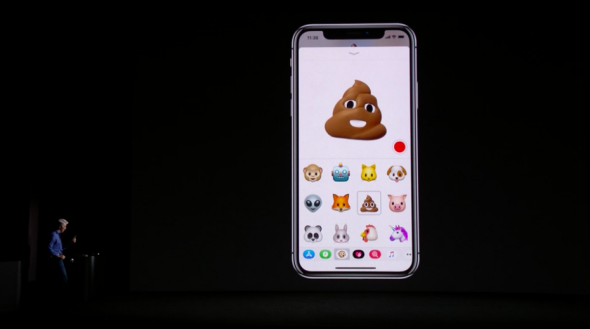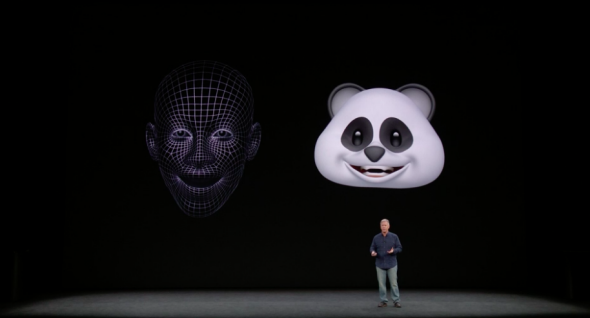The audiences at Apple’s annual announcement events are notoriously vocal. Presented with a parade of incremental advancements—and the occasional real leap forward—they dutifully hoot and applaud, their celebrations so routinized that it’s hard to distinguish real enthusiasm from mere signs of life.
One detail at this year’s event did, however, seem to produce a genuine reaction from the crowd: the company’s description of a new feature that it calls animoji, which has apparently been in the works since at least 2011. “We use emojis to communicate with others to express emotion,” declared Apple Senior Vice President Philip Schiller, gesturing broadly with his hands, his own face placid. “But of course you can’t customize emojis; they only have a limited amount of expressiveness to them.” Never mind that the relative simplicity of emojis is the key to their charm. It is, as many have argued, precisely their limitations that can make them such provocative tools. With animojis, Apple is prepared to change that, offering us the ability to bring these minimalistic characters to life.
Animojis “are emojis that you control with your face,” Schiler said as a toothy panda mask bobbed and grinned (somehow more menacing than charming) on the massive screen behind him. “Animojis track more than 50 facial muscle movements. They’ve been meticulously animated to create amazing expressiveness.” As Craig Federighi went on to explain, these animations are possible thanks to the facial recognition hardware packed into the new iPhone X. It is, in other words, of a piece with the same technology that will let you unlock your phone by looking at it and swiping up.
His salt and pepper hair a CGI’d swoosh, Federighi demonstrated that animoji will be included directly within the phone’s messaging app. “It immediately starts tracking me, so I can make whatever expression I want,” Federighi said as he snarled like a “ferocious” cat, bawked like a chicken, and whinnied like a unicorn, “mythical creature, favorite of the startup.” The system even lets you bring the poop emoji to life. Or, as Federighi put it, “If you were, by chance, wondering what humanity would do when given access to the most advanced facial tracking technology available, you now have your answer.”

Apple
The demonstration concluded with an exchange of audio animoji messages between Federighi (speaking as a fox) and Apple CEO Tim Cook (as an alien) in which the latter told his subordinate to “wrap this up.” It was a cute bit, but it was also one that should trouble those concerned with the increasing reach of mobile technology. Here, in ascending order of significance, are three reasons:
The first is the least worrisome, but it may be the most irritating. In effect, the potential for spoken, animated messages that Federighi showed off promises to reinvent voicemail for a generation of users who prefer text messages. It does so, however, with one crucial—and potentially maddening—difference: To watch the animation, you have to look at your phone while listening to the audio snippets (as you would while reading a text message) instead of holding it to your ear (as you would while checking a traditional voicemail).
This approach will likely encourage users to play the messages aloud through the phone’s speakers—possibly over and over again, especially if they find the animation amusing. In other words, unless you happen to have headphones attached, Apple is inviting you to fill the surrounding space up with the sonic clutter of your friends’ voices. Those sitting next to you on the bus are unlikely to find the results as amusing as you do.
Second, animoji looks like a sly gambit designed to help sell the almost $1,000 iPhone X. The feature likely won’t be available on devices without facial recognition technology—and the X seems to be the only handset in Apple’s lineup that has this capacity yet. But where I may not be able to create animojis on my iPhone 6, I almost certainly will be able to receive them through its messaging ecosystem.
Thus, like iMessage itself—which already distinguishes between your communications with Apple users and those on other platforms—the mere ability to use animoji will become a status symbol. It may, in effect, signify that your interlocutor was willing to plunk down a cool grand for the privilege of ventriloquizing an anthropomorphic pile of poop. While that arguably reflects poorly on them, your inability to respond in kind may say something even worse about you. In that respect, animoji itself is a kind of blackmail.
Third and finally, the very charms of the system are themselves troubling. As many have already noted, and as others will point out, employing facial recognition as a security feature comes at a risk, since it potentially makes it easier for others to unlock your device by holding it up to your face. It also represents the consumer-level creep of technology that can be used to identify protesters and otherwise put personal privacy in jeopardy.
Apple surely knows all of this, and that’s likely why it spent so much of its presentation focused on this adorable but largely inconsequential new feature. With animoji, Apple is, as the literary theorist Roland Barthes might put it, effectively inoculating us against such concerns. You may not, the company implicitly acknowledges, like living in a techno-surveillance state. But you’re going to love playing with this talking panda face. Have fun!!!!
The worst part? If the audience reaction is any indication, Apple is almost certainly right.
